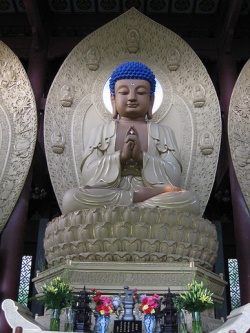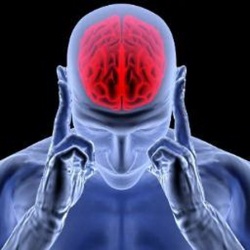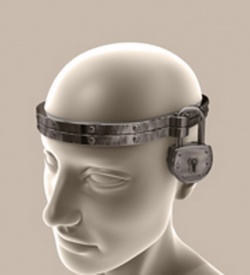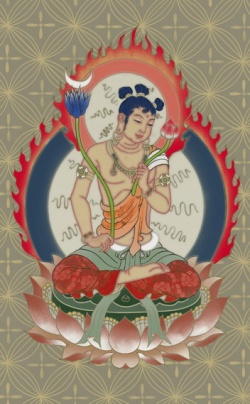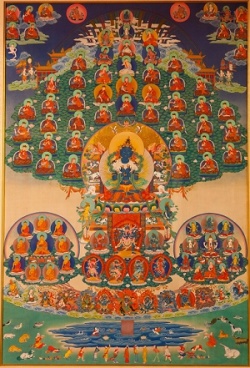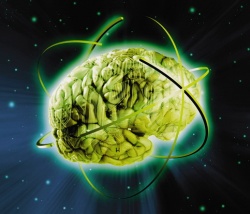Embodied Nonduality
Embodied Nonduality
Published in Undivided, an online journal at http://undividedjournal.com/?p=536
By Judith Blackstone
In this paper I describe an approach to embodied nonduality called the Realization Process. By embodied, I do not mean just the ability to walk around in our daily life, recognizing nonduality. I mean the nondual transparency of the body itself. This is an experience (I will talk more about this word "experience" later in the paper) that we are made of transparent, space-like presence, that this is our basic or true nature, and that everything that we perceive around us is also made of transparent, space-like presence. Rangtong and Shentong Views of Nonduality In order to explain how we can embody nonduality, I will begin by clarifying what I mean by nonduality. According to Tibetan Buddhist tradition (Gymatso; Hookham; Sherab & Dongyal), there are two general perspectives on nonduality, the Rangtong and the Shentong. The Rangtong view emphasizes the emptiness, or freedom from dualities, of our basic nature, and claims that even our basic nature is empty of intrinsic reality. Rangtong states that buddhanature is "self-empty" or "empty of itself." In contrast, the Shentong view asserts that buddha-nature is rich with natural qualities, such as luminosity and bliss. These qualities are "natural" because we do not have to create them.
They are revealed, or discovered, as obscurations such as conceptual ideation and static beliefs have been relinquished. Shentong says that buddha-nature is "empty of other," meaning empty of the obscurations that conceal the luminous, blissful expanse of our basic nature. Tsultrim Gyamtso Rinpoche writes, "It is empty in the sense that it is free of all the obscurations created by the conceptual mind. Therefore when the conceptual mind tries to grasp it, it finds nothing and so experiences it as emptiness. Thus, it is empty to the conceptual mind, but from its own point of view it is the Clear Light Nature of Mind together with all its qualities" (2001, p. 75). I think it is important that we understand the distinction between these views. Although the language comes from Buddhism, it can just as easily be applied to different interpretations of Advaita Vedanta. This division can help us make sense of the contradictions among different teachers, and make an informed decision about what type of realization we want to approach and what practice to choose.
Although I am aligned with the Shentong view in this paper, and in all of my writing and teaching, I believe that both views are useful to different people or at different phases of one's path. The Rangtong view is usually approached through a deconstructive method in which mental fixations, and all notions of duality, are confronted and eliminated. Some Rangtong teachings focus on the impermanence of the created world. Because everything is made up of parts, it cannot be said to truly exist in itself. For example, there is really no such thing as a chair, other than our conceptual attribution of chairness to the parts that make up the chair. Other Rangtong teachings cultivate the idea of all-inclusiveness. They argue that if nonduality is said to be any particular way of being and knowing, then this is duality because it rejects other ways of being and knowing. This is an effective way to let go of our conceptual "grip" on life, in which we distort and manipulate our experience to achieve what we want and reject what we don't want. The Rangtong approach can lead to the direct, unmediated perception of phenomena, along with spontaneous, unmediated expression and action. In other words, it can facilitate spontaneous participation in life, unhampered by mental ideation.
From the Shentong perspective, one of the main limitations of the Rangtong view is that it uses mental processes to rid ourselves of our mental processes. One needs to hold onto and continually reinforce the mental concepts of impermanence or inclusivity in order to maintain the (conceptual) recognition of nonduality. It may become an intellectual stance toward life rather than an actual letting go of ourselves. When this approach does achieve an actual letting go, this usually occurs in the realm of perception, as a sense of immediacy in which any selfconsciousness or mental ideation is subsumed by perceptual stimuli, rather than as an openness of our whole being. The Shentong view points beyond a mind that is free of conceptual distinctions to a realization, or laying bare, of an extremely subtle dimension of our being. In the Shentong view, we are nondual consciousness. We are of the same luminous essence as everything in nature.
The Chandogya Upanishad expresses it like this: “That subtle essence this whole world has for its self. That is the True. That is the Self. That thou art.” The medieval Tibetan Buddhist master Longchenpa writes, "“This vast expanse, unwavering, indescribable, and equal to space, is timelessly and innately present in all beings” (Rabjam, 2001, p. 83). And: "The consummate meaning of the heart essence is that of ineffability, openness, spontaneous presence and oneness" (1998, p. 75). Shankara, the Hindu nondualist, writes, “The one and the same Self is in all beings…everything is pervaded by the Self which is considered to be pure and consisting of the Light of Pure Consciousness” (1989, p. 154). And: “I am the Supreme Brahman which is pure consciousness, always clearly manifest, unborn, one only, imperishable, unattached, and all-pervading and non-dual (p. 111).”
This spacious, all-pervasive transparency is the basis of direct, unmediated, all inclusive experience and spontaneous action. It is the transparency through which life flows. It is the one (the consciousness or Self) who observes and experiences this unobstructed flow. Tsultrim Gyamtso Rinpoche writes, “The Shentong argues that if there really were no conceptual contrivance in the mind the Clear Light Nature would shine forth so clearly and unmistakably that it would not be possible to deny it” (2001, p. 68). The Experience of Nonduality I do not think that it is necessary to make metaphysical assertions about things like "universal essence." I believe that all metaphysical claims, whether of emptiness or of selfexistent nature, even when they are embedded in the most sacred spiritual texts, are interpretations of various kinds of experience. For this reason, I attempt to focus my teaching on experience. We can experience our own body and everything around us as transparent, as made of (or pervaded by) a single, luminous, sentient, unbounded expanse of transparency.
The Buddhist Heart Sutra says, "form is emptiness, emptiness is form." This phrase is usually interpreted philosophically: emptiness means impermanent or arising out of conditions and therefore not inherently existent, and the Heart Sutra is saying that all forms are empty in this way. But there is another, more mystical (meaning experiential) way that this phrase can be understood. For it is a very precise, accurate description of the how all forms appear in nondual consciousness. They are both substantial and transparent at the same time. Kashmiri Shaivism scholar, Muller-Ortega writes, “No longer do finite objects appear as separate and limited structures; rather, the silent and translucent consciousness out of which all things are composed surfaces and becomes visible as the true reality of perceived objects” (1989, p. 182). The word "experience" is often denigrated by Rangtong teachers. In their view, nondual consciousness cannot be experienced because it is not a thing.
It is empty of itself. It is also understood, in the Shentong view, that nondual consciousness is not an experience in the usual sense. Because it is who we fundamentally are--because nondual consciousness is the experiencer--it is not experienced as an object separate from ourselves. And yet, it experiences itself. In Buddhist teachings, it is said to be "self-knowing" (Rabjam, 2001). We would not know about this "wisdom mind" if it could not be experienced. Anything that is "beyond experience" is only a matter of speculation or inference. But the unified, sentient transparency that I am calling nondual consciousness is not speculation; it can be directly experienced (it can experience itself). Longchenpa acknowledges this when he writes: “Within the spacious expanse, the spacious expanse, the spacious vast expanse, I Longchen Rabjam, for whom the lucid expanse of being is infinite, experience everything as embraced within a blissful expanse, a single nondual expanse” (Rabjam, 2001, p. 79). The Siva Sutras, one of the main source texts of Kashmiri Shaivism, states, “The individual mind intently entering into the universal light of foundational consciousness sees the entire universe as saturated with that consciousness” (trans. Singh, 1979, p. 59).
Embodiment One of the traditional Shentong approaches to realizing nonduality is to settle one's attention in an all-inclusive fashion on the present moment, so that each moment registers in one's mind as an undivided whole. This is wide-open, relaxed focus is meant to eventually reveal the self-knowing consciousness that is distinct from the changing phenomena that it reflects and encompasses. But this practice also has limitations. Practitioners of this method often hold themselves in a fixed stance of "openness." This fixed pattern of attention, like any fixed attitude, obstructs the flow of experience. It may also prevent the emergence of the nondual dimension of consciousness that it is meant to reveal. The transparency of nondual consciousness is more subtle than our ordinary attention. It pervades the objects it perceives, rendering all of experience both transparent and substantial at the same time. Also, when people settle into a wide-open focus, they often leave out the perception of the internal space of their own body. They focus, all-inclusively, on the world around them. When they "just let go" of themselves, they let go into the world around. They expand outwardly. However, we cannot arrive at the all-pervasive transparency of nondual consciousness unless that transparency also pervades our own body. For this reason, we do not awaken to nonduality if we just let go from the surface of ourselves into the world around us.
We need to let go from deep within the body, from all the way through the body, to truly awaken. And for most people, this takes some work. Although nondual realization itself is entirely effortless, entirely without any sort of contrivance, we need to do the focused practice of subtle inward attunement in order to let go from deep within ourselves. But then we are able to really let go. We do not have to continually reinstate either our conceptual understanding or our wide-open focus. This means that nonduality is not something that we only experience when we remember to focus or conceive of life in a particular way. When we realize nondual transparency throughout our whole body, we uncover ongoing, effortless nondual reality. Another reason that embodiment is necessary for nondual awakening is that the fixations that obscure nondual reality are not just conceptual. Our fixed grasp on ourselves and the world is not just mental but also somatic. There are rigid holding patterns throughout the whole body, limiting our capacity for cognition, emotional responsiveness and physical sensation.
We created these constrictions in childhood in response to painful or overwhelming events in our environment. Even our sensory perception is limited by the {{Wiki|psychologically]] based constrictions throughout our whole body. So if we hold our attention open on the present moment, we will only be as open and attentive as our somatic patterns of constriction allow. Also, the memories, childhood mentality, and emotional charge that are bound in our somatic holding patterns continue to exert their influence on our present day awareness. For example, a fearful cringe held in our body, along with the memory of danger, will keep promoting a sense that the world is dangerous, no matter how much we try to open our mind, or divorce ourselves from our childhood "story." Because we are nondual consciousness, we need to open our whole body and being to this foundation of ourselves. The Qualitative Self As we inhabit the internal space of the body, the constructed or imagined boundary between self and other dissolves. We find that, at root, we are of the same transparency as everything around us.
At the same time, however, by inhabiting our body, we experience an internal coherence, an individual wholeness. We are able to experience, and to be, our whole individual self at once. This means, for example, that we can feel, think and sense at the same time. In this way, nondual realization both encompasses and surpasses the duality of self and other. What falls away are the ideas of self and other that obscure the direct, moment-to - moment experience. To experience our internal wholeness dissolves the conceptually based boundary between self and other, along with the defensive, strategizing self. We become transparent, disentangled, spontaneous, but we are still here, still present, even more present than before. The sense of truly existing is an integral and surprising aspect of uncovering your spiritual essence. Sometimes the Rangtong teaching if no-self is interpreted that there is no being there at all, just emptiness.
But to be empty is not the same as being hollow. All through the history of Asian spiritual philosophy, there has been recognition that an authentic sense of self is revealed as our fixed concepts of ourselves are relinquished. For example, the revered Hindu teacher, Ramana Maharshi made a distinction between the true "I am" and the conditioned experience of self, such as "I am a doctor" (Godman, 1992). And consider this passage from the 9th century Chinese Zen master, Lin Chi (Japanese: Rinzai): An ancient doctor says that the body is dependent on its meaning, and the ground is describable by its substance. Being so, we know that Dharma-body and Dharma-ground are reflections of the (original) light. O Venerable Sirs, let us take hold of this person who handles these reflections. For he is the source of all the Buddhas and the house of truthseekers everywhere. The body made up of the four elements does not understand how to discourse or how to listen to a discourse. Nor do the liver, the stomach, the kidneys, the bowels. Nor does the vacuity of space. That which is most unmistakably perceivable right before your eyes, though without form, yet absolutely identifiable—this is what understands the discourse and listens to it. The person “who handles these reflections” is who we actually are.
We are not the vacuity of space. We are the one who is always there beyond the changing content of our experience. And we can know this person, we can know that we are this true person, by realizing the nondual ground of our being. The internal coherence that is revealed as we inhabit our body has qualities that can be experienced as the qualities of our being. Our intelligence, for example, is not just a function, it has a qualitative "feel." Our love, power, sexuality, have qualities that we can experience as part of the actual experience of being alive. As we realize nonduality, we shift from a conceptual stance to the actual experience of ourselves and our environment. We shift from a constructed reality, to reality itself. A Zen story has a monk showing a flower to his student and saying, "Most people see this flower as if in a dream." In nonduality, we awaken from the dream of life to the experience of life. The qualities that we discover when we inhabit our body are universal. Just as we can recognize the feel of love in another person because it is the same quality that we have felt, we can recognize and resonate with all of the qualities of another person's being. This is an aspect of our oneness, with other people, and with all of nature.
According to the Shentong Buddhists, wisdom mind has inherently the qualities of emptiness, bliss, and luminosity (or clarity). According to some Hindu teachings, pure consciousness has inherently the qualities of truth, intelligence and bliss (Sanskrit: sat-chitananda). The all-pervasive spaciousness of nondual consciousness can be experience as both sheer transparency and as the quality-rich ground of being. Within our own body, our basic nature can be experienced as both transparency, as if we were made of empty space, and as quality-rich presence. But even our unique individuality, with its memories, talents, opinions, and preferences is more clearly revealed, more intimately known in the clear, unobstructed space of nondual consciousness. The twentieth century Japanese philosopher, Nishitani, writes, "It is the field in which each and every thing—as an absolute center, possessed of an absolutely unique individuality—becomes manifest as it is in itself" (1983, p. 164). As nondual consciousness, our perceptions, thoughts, emotions and sensations move through the pervasive spaciousness, without altering the transparency in any way. This means that nondual realization can remain stable even during reflexive thinking, intense emotion, or while engaged in the mutual exchange of relationships. Nondual consciousness pervades and encompasses these basic functions of our being, without eradicating them.
The Realization Process I teach a series of practices called the Realization Process. In this approach, the radical openness of nondual awakening is discovered by making deep contact with the internal space of one's body, and with a subtle channel that runs vertically through our torso, neck and head. These practices are supplemented by a method of releasing somatically bound psychological holding patterns in order to more fully inhabit one's body. To inhabit the body is different than being aware of the body. It means that we are actually present within the internal space of the body. We experience that we are the internal space of the body, this is part of who we are. As I have said, inhabiting the body reveals both an internal coherence and the subtle nondual transparency that pervades self and other as a unity. Although the Realization Process emerged out of the obstacles and insights of my own path, and in response to the needs of the people who have come to practice with me, there are many references to the realization of the body in the Asian spiritual literature.
The Japanese philosopher, Yuasa, writes, “The ‘mind’ here is not surface consciousness, but is the ‘mind’ that penetrates into the body and deeply subjectivizes it” (1987, p. 105). In the Realization Process, we consider total mind-body integration to be an ideal that we can progress toward. We do not need to release all of our holding patterns in order to realize nonduality. However, even after we have stabilized in nondual reality, we can continue to become increasingly open to the unity and transparency of our body and environment. The Subtle Core The most effective way that I have found to let go of our somatic grip on ourselves is by accessing the subtle core of the body. The subtle core of the body is conceived as a slender vertical channel that runs from the center of the bottom of the torso (and below) to the center of the top of the head (and above). It is called the central channel or the "wisdom channel" in Tibetan Buddhism and sushumna in the Indian Yoga system.
From this slender core of ourselves, we are disentangled from all of the content of our experience. In Yoga, sushumna is said to consist of three channels, nested within each other. The innermost channel is considered to be the most subtle channel. In Realization Process, we also penetrate with our focus into the innermost core of this channel. Eventually we feel that we are living within this channel, that this channel is part of who we are. We cultivate access to this channel by finding points within the core of the body, and initiating the breath within these points. We can enter into the subtle core of the body anywhere along it, but in the Realization Process, we enter mainly through the center of the head, chest and pelvis. The center of your head can be found approximately between your ears, in the very center of the internal space of your head. In other words, I do not mean the center between the brows or the top of the head. When you enter into this point in the center of your head, you will feel a subtle vibration down through your whole core. Most people find this point too high up in their heads. If you can feel the vibration downward through your whole core, you know that you have found the point in the center of your head.
The points in the center of the chest and pelvis are found by focusing inwardly as deeply as you can without strain, in your chest and pelvis. All of the points within the subtle core of the body can be recognized by their subtle vibration. It is important to find the point by the feel of it, rather than by an anatomical location. Wherever we enter into the subtle core of the body, it feels as if we have entered into our whole being. When we breathe within any point in the subtle core of the body, the breath produces a subtle vibration throughout the whole body. It has often been said that there is no center in the realization of nonduality. It can also be said that the center of nonduality is everywhere. Once we become adept at finding the innermost core of our body, we find that we can enter into our whole body/being at once through anywhere in our body. We can also feel a resonance between the subtle core of our own body and the subtle core of another person's body. The center that is everywhere in our body is the same center that is everywhere in another person's body.
The subtle core is an entranceway into the wholeness of our own body/being and the oneness that transcends our individual being. By letting go from the subtle core of the body, we let go into the fundamental dimension of our being. We find ourselves as the pervasive, unified transparency of self and other. From the subtle core of the body, we can release our limiting grip on our experience, so that our thoughts, feelings, sensations and perceptions can flow more fluidly. We can also let go of our fixed patterns of self and other, so that they actually dissolve. In this way, nondual awakening becomes an enduring, stable transformation of being. It is not a state of being, which implies a fixed position or fixed focus, and it is not a transitory "peak" experience. To embody nondual reality is to become more alive within our own skin.
and moreover, is aware of itself" (quoted in Stambaugh, 1999). It has seemed to me that nonduality is sometimes taught with a punitive attitude, as a form of self-denial rather than as a path to getting out of our own way in our enjoyment of life. But the realization of nonduality makes life more vibrant, more impactful and often more pleasurable. We do not become zombies, unable to respond to our environment or to remember the richness of our individual histories. By uncovering our fundamental nondual nature, we become authentic human beings, transparent and present at the same time.
References
Godman, D. (1992). Be as you are: The teachings of Sri Ramana Maharshi. New Delhi:
Penguin Books India.
Gyamtso, K. T. (2001). Progressive stages of meditation on emptiness. Auckland, New Zealand: Zhyisil Chokyi Ghatsal Publications.
Hookham, S. K. (1991). The Buddha within. Albany, NY: State University of New York Press.
Lin Chi (D. T. Suzuki, Trans.). Retrieved November 20, 2011 from
website:http://enlight.lib.ntu.edu.tw/FULLTEXT/JR-AN/an141158.pdf ).
Muller-Ortega, P. E. (1989). The triadic heart of Shiva. New York: State University of
New York Press.
Nishitani, K. (1982). Religion and nothingness. Berkeley and Los Angeles, CA:
University of California Press.
Rabjam, L. (1998). The precious treasury of the way of abiding (R. Barron, Trans.).
Junction City, CA: Padma Publishing.
Rabjam, L. (2001). The precious treasury of the basic space of phenomena (R. Barron,
Trans.). Junction City, CA: Padma Publishing
Sankara (1989). Upadesa sahasri (S. Jagadananda, Trans.). Madras: Sri Ramakrishna
Math.
Sherab, P. & Dongyal, T. (2007). Rangtong and Shentong views. Sidney Center, NY: Dharma
Samudra.
Stambaugh, J. (1999). The formless self. Albany, NY: State University of New York Press.
Yuasa, Y. (1987). The body. (N. Shigenori & T.P. Kasulis, Trans.). Albany, NY: State University
of New York Press.
